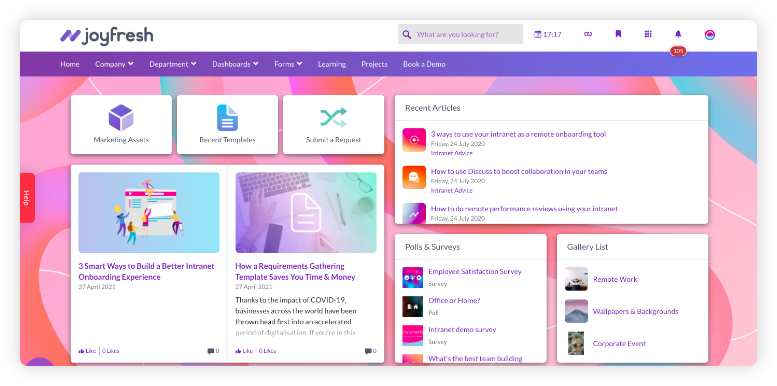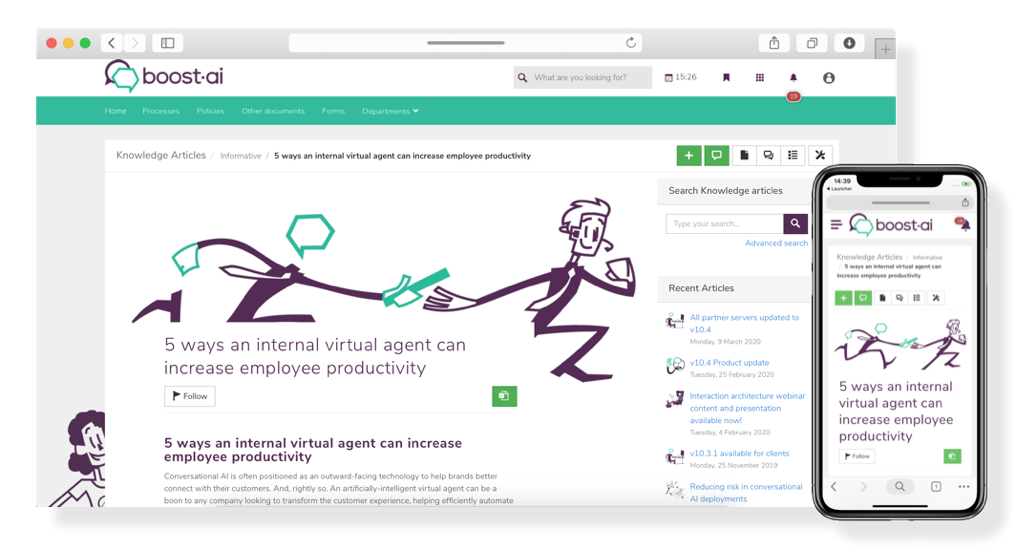Intranets have been around for a long time, and have come far since their initial implementation. Indeed, intranets have evolved from a static information portal into a suite of digital tools that improve collaboration and boost the employee experience. Most notably, intranets sit at the heart of the digital workplace, providing teams with a virtual work environment that supplements – or even replaces – physical offices.
But what is a digital workplace exactly, and how does it relate to intranet software tools? Before we explain all, it’s useful to understand the development of intranets over the years. Let’s take a quick history lesson:
How have traditional intranets evolved?
The first intranets were certainly different from how we know and use them today, and originally consisted of static webpages, hosted on a private network, for the purposes of providing information to staff members.
Fast forward a few years, and intranet solutions started to evolve into platforms that focussed on improving internal communications, with easy access to documents and an employee directory.
Traditional intranets were a corporate entity, focusing mainly on providing employees with a platform for accessing information quickly. Furthermore, company intranets were often proprietary; intranet platforms needed a specialised suite of applications installed and were only accessible within the company’s network, making them rather difficult to manage and maintain. Certainly, elements such as an engaging intranet design and user experience – which are staples of modern intranets – were not a top priority.
The surge of popularity of the internet sparked a revolution in the intranet vendor industry, changing the way companies used them. Intranets began to be accessible and managed online in the cloud, rather than tied down to an organisation’s individual infrastructure, making them easier to manage and customise.
As intranet software technology and functionality advanced, so too did the intranet user’s expectations. Consumer and business tech started to merge, meaning users expected their company intranet to include corporate social media, collaboration tools, and employee engagement-boosting features. As remote work and the demand to communicate on the go via mobile devices increased, intranets needed to be accessible on mobile apps as well as desktop.
Trying to capture employees’ attention via an engaging user experience is now one of the most important challenges businesses face when rolling out their digital transformation strategy. So how can this be improved?
A great solution is to consider intranet users as consumers in order to understand and deliver their expectations. This makes things a lot easier, as it changes the focus from a corporate to a consumer mindset. And this is where the digital workplace makes an entrance!
What is a digital workplace?
A digital workplace is a virtual embodiment of a physical office, where functionality such as document management, information sharing capabilities, communication tools, employee engagement apps, business productivity features, and more are unified into one comprehensive hub.
Digital workplace integrations are also a key part of the system, allowing organisations to easily connect their third-party tools and centralise their business software into a single space.

Digital workplace software centralises all your business productivity apps into a single location
A digital workplace is also portable, allowing users to take their work wherever they go, allowing for total autonomy. Furthermore, by bringing in collaborative and social tools, company intranets become a fun and creative place to be, which enables employees to easily engage with the software.
As we mentioned above, a good user experience is paramount to your digital workplace strategy. Staff are accustomed to using software that looks great and works intuitively, so it’s important that your digital workplace technologies fulfil the same criteria.
These digital workplace features are what a consumer would expect as standard from the digital technology they use in their leisure time. By applying these guidelines to your internal business software, you’ll see improved employee productivity, a stronger company culture, and an overall better employee experience for your office-based teams and remote workers alike.
Digital workplace examples
Now you have a good idea of what a digital workplace is, let’s take a look at a couple of examples to see it in action!
Boost.ai
Conversational artificial intelligence (AI) company Boost.ai uses their digital workplace to centralise all their specialist knowledge into one hub, so that external partners have easy access to the information they need to onboard their customers.

(Source: claromentis.com)
Internal communication tools help Boost.ai’s teams to share information about the latest webinars and product updates, whilst collaboration tools allow staff to document their educational resources in an engaging format.
Emergency Physicians of the Rockies
Emergency Physicians of the Rockies (EPR) provide urgent medical care across Northern Colorado. With 7 emergency departments out on the field, EPR needed to implement a digital transformation strategy that kept their physicians connected on-the-go.

(Source: claromentis.com)
Because their digital workplace software can be used on any mobile device, EPR field workers could easily get the most up-to-date information at all times. Knowing that they have easy access to accurate data has improved staff happiness, which of course is known to have a positive impact on employee retention.

![[FREE GUIDE] 7 Ways You Can Boost Engagement Using Your Intranet](https://no-cache.hubspot.com/cta/default/5025095/9e73ea1b-d562-4945-bfd7-45d18f4dca99.png)




